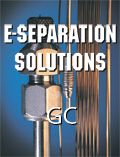Gas Chromatography
Joining us for a discussion on gas chromatography this month are Eric Phillips of Thermo Fisher Scientific and Ngoc Nguyen of Phenomenex.

World events such as the Gulf Oil Spill only serve to remind us how important the techniques of GC and GC–MS are. With testing of the food chain largely accomplished with these techniques, GC and GC–MS are once again in the spotlight.
Joining us for this discussion on gas chromatography this month are Eric Phillips of Thermo Fisher Scientific and Ngoc Nguyen of Phenomenex.
What has been the most significant breakthrough in GC over the last 5-10 years?
Phillips:Decrease in price and increase in performance is the most significant breakthrough. Speed of analysis, sensitivity, and dynamic range have dramatic impacts on all types of analyses. These have provided significant decreases in cost per sample for those using the latest technologies. In addition, application of advanced multidimensional techniques to routine applications, such as backflush, enable customers to take advantage of tools that can further enhance performance and instrument uptime.
Nguyen: Though GC is an established technique in many industries, there have been a few breakthroughs over the last few years: increased high temperature limits and unique selectivity. Column manufacturers are now making fused-silica GC columns with temperature limits on par with some metal columns (430 °C). This has allowed chemists to extend their analysis by separating compounds that were previously challenging, such as high molecular weight compounds. In addition, columns with unique selectivities have enabled chemists to better understand their samples. This is especially useful for industries that require better resolution of complex mixtures, such as toxicology or environmental testing.
GC can be used for many different applications, but which does it have the largest impact on (or possible impact)?
Phillips:GC and GC–MS are some of the most widely used techniques in the analyses of small organic compounds. There is not one area in which advances in GC have had the largest impact. The latest technologies have the most impact on the laboratory’s bottom line. The laboratory can analyze samples faster, with fewer dilutions, and at lower levels than ever before. Laboratories using this technology are also able to produce less hazardous waste.
Nguyen:With the recent Gulf Oil Spill, GC is having a large impact on environmental testing. To help understand the impact that the oil spill has caused, laboratories are looking for rapid and robust analytical procedures to characterize the hydrocarbon contaminants. GC is able to provide fast and sensitive analysis for the most common contaminants that originated from the leak, such as polycyclic aromatic hydrocarbons (PAHs), petroleum hydrocarbons (PHCs), and volatile organic compounds (VOCs).
What current trends have you the most intrigued in the GC field?
Phillips:The pressures on manufacturers have been to make faster, more sensitive, less expensive systems. I am excited by all of the new products that are available to meet those demands. These pressures are driving development that we would not have seen 5 years ago. Ultra fast GC and GCxGC are two specific techniques. Miniaturization of the GC, to suitcase and credit card size, is another interesting way of meeting that pressure. Mass spectrometers will continue to decrease in size and increase in performance.
Nguyen:GC has been an integral part of some of the most devastating crisises we have encountered recently. From the melamine crisis to the 2010 Gulf of Mexico Oil Spill, GC has not only been used to better understand the impact of the crisis but to set rules and regulations to help prevent such occurrences from happening in the future.
Are there any obstacles standing in the way of GC development?
Phillips: The GC and GC–MS markets are broad. The need for analysis of small organic compounds will remain strong, and increase. The only obstacle is a lack of imagination on how the development will proceed.
Nguyen: The main limitation right now is sensitivity for GC-MS. More and more applications are moving to LC–MS-MS because they are able to analyze at much lower levels and without the need for derivatization. GC can achieve these detection limits, but only with analyte specific detectors such as ECD and NPD. Labs want the positive confirmation that MS gives you. To stay competitive, MS sensitivity needs to be improved. In addition, many laboratories are favoring LC–MS-MS because it requires less sample preparation. A large part of an analyst's time is spent cleaning and preparing samples. Thus, many methods are being moved to LC–MS-MS because the analytes are more stable and require less sample preparation before analysis.
What do you expect to see in the future for GC?
Phillips: I continue to expect to see smaller, less expensive GC systems that are able to meet increasing market requirements for more sensitivity, wider dynamic range, and faster separations. I also expect to see GC columns that will keep up with the demands of the analyses and the instruments, as well as providing better separations. Compatibility with green chemistry and environmental concerns, such as disposal and energy consumption, will allow the GC systems of the future to fit the changing needs of tomorrow’s laboratories.
Nguyen: Since GC is an established technique, the future is not so much in new applications areas but in developing turnkey solutions. Analysts are looking for solutions that are simple and easy to implement.
If you are interested in participating in any upcoming Technology Forums please contact Associate Editor Meg Evans for more information. Next month’s forums will focus on the TLC and Data Handling/Information markets.
Study Examines Impact of Zwitterionic Liquid Structures on Volatile Carboxylic Acid Separation in GC
March 28th 2025Iowa State University researchers evaluated imidazolium-based ZILs with sulfonate and triflimide anions to understand the influence of ZILs’ chemical structures on polar analyte separation.










